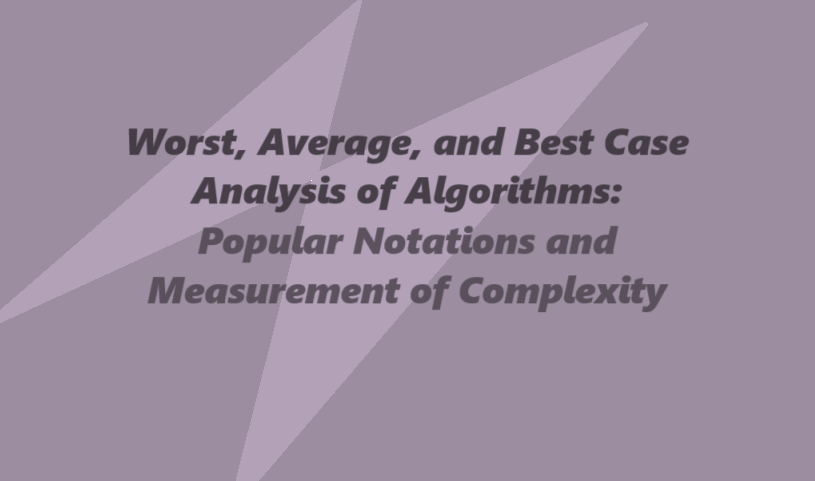Introduction
When analyzing algorithms, it is important to understand their performance characteristics. This analysis helps us determine how efficient an algorithm is and how it will behave under different scenarios. In this blog post, we will explore the concepts of worst, average, and best case analysis of algorithms, popular notations used in complexity analysis, and the measurement of algorithmic complexity.
Worst Case Analysis
Worst case analysis involves determining the upper bound on the running time of an algorithm for the input that results in the maximum number of operations. It gives us an idea of the maximum time an algorithm will take to complete its execution. This analysis is particularly useful when we want to ensure that an algorithm performs well even in the worst possible scenario. For example, consider a sorting algorithm. In the worst case, the input array may be in reverse order, requiring the maximum number of comparisons and swaps. By analyzing the worst case, we can determine the upper bound on the time complexity of the sorting algorithm.
Average Case Analysis
Average case analysis involves determining the expected running time of an algorithm for a random input. It takes into account the probabilities of different inputs and their corresponding running times. This analysis gives us a more realistic estimate of an algorithm’s performance under typical conditions. Continuing with the sorting algorithm example, average case analysis considers the probability distribution of different input arrays and calculates the expected number of comparisons and swaps required. This analysis provides a more accurate assessment of the algorithm’s efficiency in real-world scenarios.
Best Case Analysis
Best case analysis involves determining the lower bound on the running time of an algorithm for the input that results in the minimum number of operations. It gives us an idea of the minimum time an algorithm will take to complete its execution. However, best case analysis is not very informative on its own, as it often represents unrealistic scenarios that rarely occur in practice. For the sorting algorithm example, the best case occurs when the input array is already sorted. In this case, the algorithm may have a lower time complexity compared to other scenarios. However, the best case analysis alone does not provide a comprehensive understanding of the algorithm’s performance.
Popular Notations in Complexity Analysis
Complexity analysis involves expressing the growth rate of an algorithm’s running time or space requirements as a function of the input size. Several popular notations are used to represent algorithmic complexity:
Big O Notation (O)
Big O notation represents the upper bound on the growth rate of an algorithm’s running time. It provides an upper limit on how the algorithm’s performance scales with the input size. For example, if an algorithm has a time complexity of O(n^2), it means the running time grows quadratically with the input size.
Omega Notation (Ω)
Omega notation represents the lower bound on the growth rate of an algorithm’s running time. It provides a lower limit on how the algorithm’s performance scales with the input size. For example, if an algorithm has a time complexity of Ω(n), it means the running time grows linearly with the input size.
Theta Notation (Θ)
Theta notation represents both the upper and lower bounds on the growth rate of an algorithm’s running time. It provides a tight estimate of how the algorithm’s performance scales with the input size. For example, if an algorithm has a time complexity of Θ(n), it means the running time grows linearly with the input size, and the upper and lower bounds are the same.
Read this: Difference between Big O vs Big Theta Θ vs Big Omega Ω Notations
Measurement of Complexity of an Algorithm
To measure the complexity of an algorithm, we consider the input size (n) and the number of basic operations performed by the algorithm. The basic operations can be comparisons, assignments, arithmetic operations, or any other operation that takes a constant amount of time. The most common way to measure complexity is by counting the number of operations as a function of the input size. For example, an algorithm that performs a constant number of operations for each element in an array of size n would have a linear time complexity of O(n).
Which Complexity Analysis is Generally Used?
The choice of complexity analysis depends on the specific requirements and characteristics of the algorithm and the problem it solves. In general, worst case analysis is commonly used as it provides an upper bound on the algorithm’s performance. This ensures that the algorithm will perform well even in the worst possible scenario. However, average case analysis is also important, especially when the algorithm is expected to handle random or typical inputs. It gives a more realistic estimate of the algorithm’s performance under normal conditions. Best case analysis, while less informative on its own, can be useful in certain cases where the best case scenario is of particular interest or when comparing algorithms with similar best case performance.
Conclusion
In conclusion, analyzing the worst, average, and best case scenarios of an algorithm provides valuable insights into its performance characteristics. Complexity analysis using popular notations such as Big O, Omega, and Theta helps us express and compare the growth rates of algorithms. By understanding the measurement of algorithmic complexity, we can make informed decisions when choosing and optimizing algorithms for different applications.

